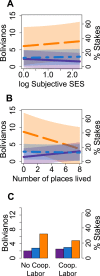Risk buffering and resource access shape valuation of out-group strangers
- PMID: 27470126
- PMCID: PMC4965756
- DOI: 10.1038/srep30435
Risk buffering and resource access shape valuation of out-group strangers
Abstract
Unlike other primates, humans exhibit extensive inter-group tolerance and frequently build relationships with out-group members. Despite its common occurrence, little is known about the conditions leading to out-group relationship building in humans. What are the social and ecological factors promoting valuation of out-group members as potential social partners? Do they differ from those promoting valuation of in-group members? We propose that opportunities for non-local resource access and resource buffering, crucial in the human foraging niche, will increase valuation of out-group strangers. Using survey and experimental data collected among three Bolivian horticultural populations, we find that individuals with fewer non-locally available resources and more information about out-groups demonstrate more generosity toward out-group strangers, but not in-group strangers. The effects are specific to subjective resource access, not objective measures of access, and out-group exposure, not stereotypes. Further, depending on the measure, existing network connections affect both out-group and in-group giving, suggesting that new partnerships from both in-groups and out-groups may bolster one's networks. Our results illustrate how evolved human psychology is sensitive to the costs and benefits of both out-group and in-group relationships, but underscore that the social and ecological factors favoring new relationships with in-group versus out-group strangers may differ.
Figures


References
-
- Bowles S. Did warfare among ancestral hunter-gatherers affect the evolution of human social behaviors? Science 324, 1293–1298 (2009). - PubMed
-
- Bornstein G. Intergroup conflict: individual, group, and collective interests. Pers. Soc. Psychol. Rev. 7, 129–145 (2003). - PubMed
-
- Van Vugt M. & Park J. H. Guns, Germs, and Sex: How Evolution Shaped Our Intergroup Psychology. Soc. Personal. Psychol. Compass 3, 927–938 (2009).
-
- Schaller M. & Neuberg S. In Foundations of Evolutionary Psychology (ed. Crawford C. & Krebs D.) 401–414 (Taylor & Francis Group/Lawrence Erlbaum Associates, 2008).
Publication types
MeSH terms
LinkOut - more resources
Full Text Sources
Other Literature Sources

